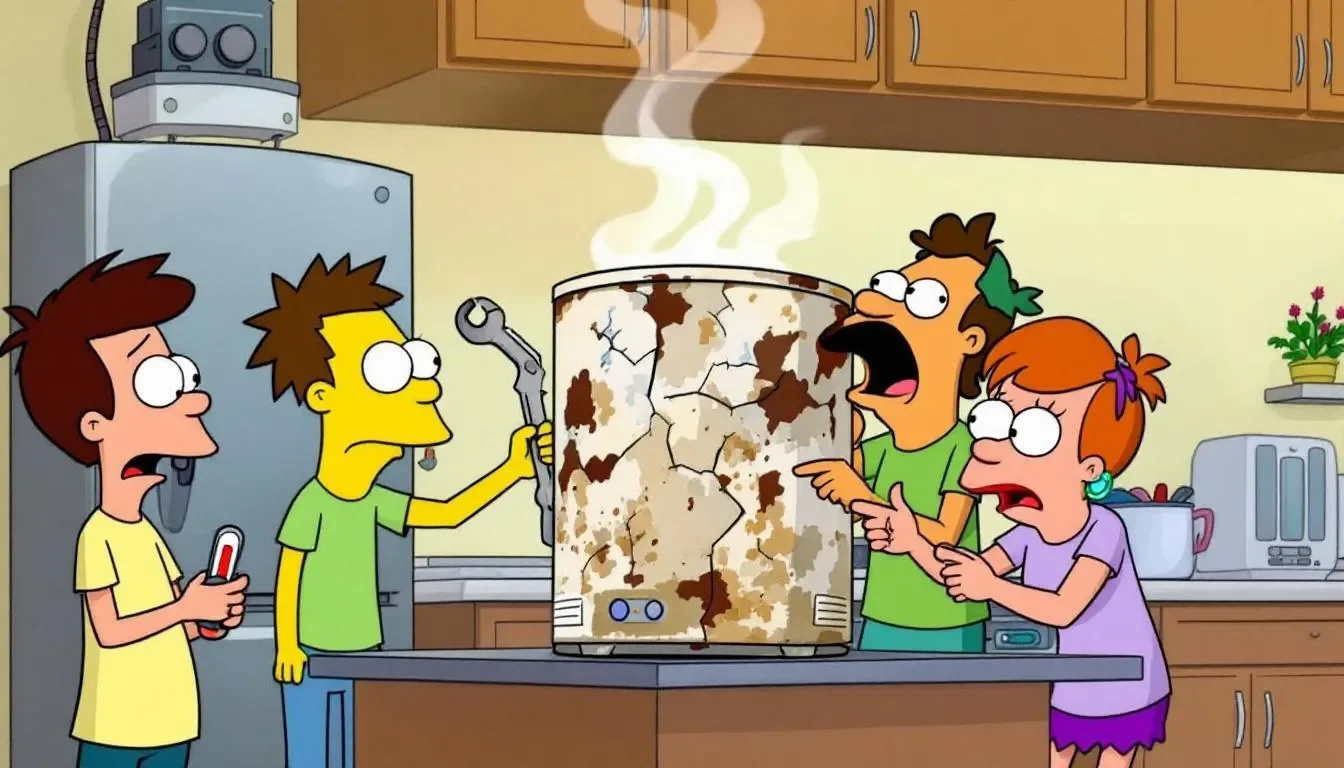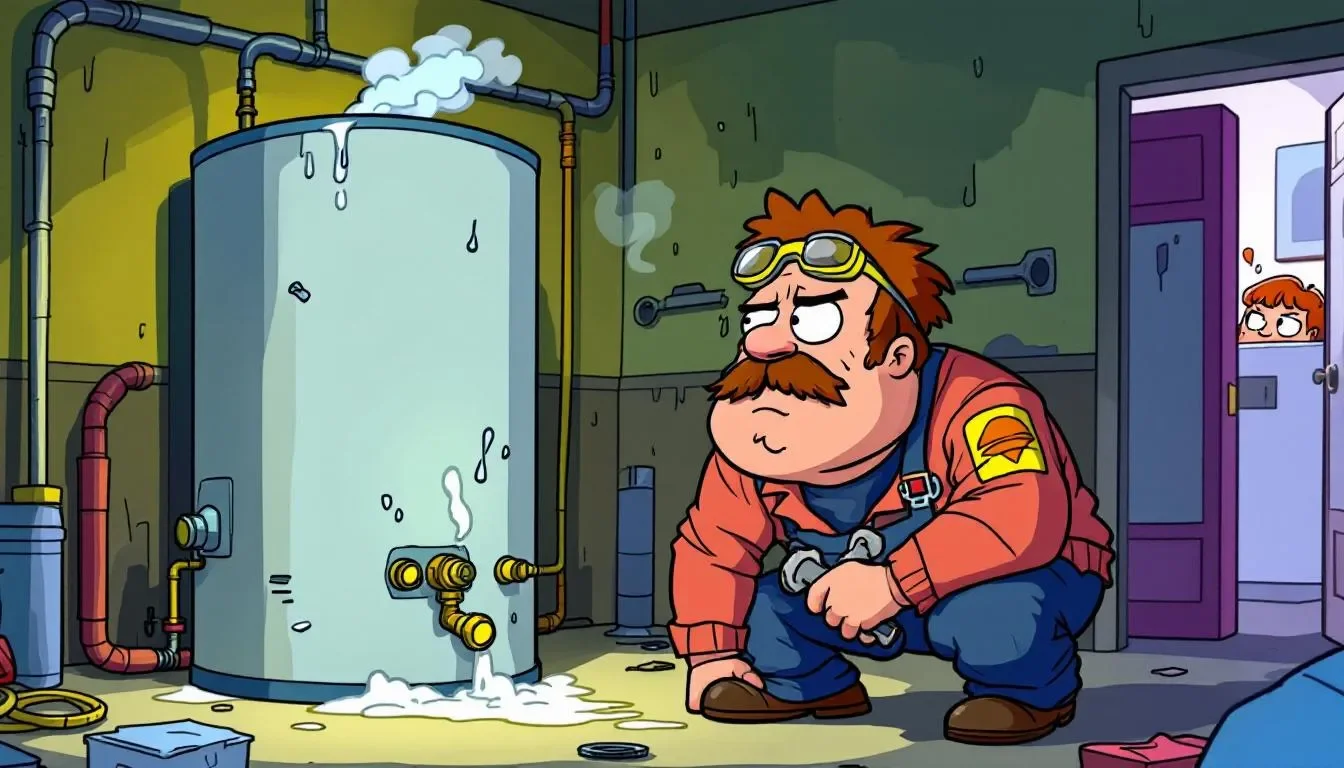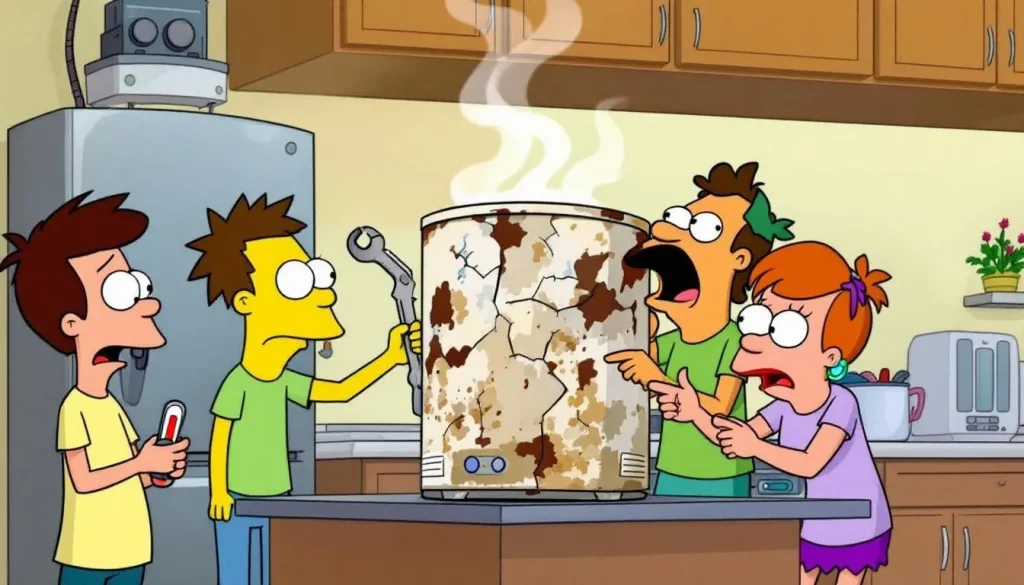Is your hot water not getting hot enough? This issue can be due to a faulty thermostat, a broken dip tube, or sediment buildup. We’ll guide you through diagnosing and fixing these common problems to restore your hot water.
Key Takeaways
Contents
- 1 Key Takeaways
- 2 Common Causes of Insufficient Hot Water
- 3 Troubleshooting Electric Water Heaters
- 4 Troubleshooting Gas Water Heaters
- 5 Addressing Water Heater Age and Capacity
- 6 Preventive Maintenance Tips
- 7 When to Call a Professional Plumber
- 8 Summary
- 9 Frequently Asked Questions
- 9.1 What should I do if my electric water heater isn’t producing enough hot water?
- 9.2 How can I tell if my dip tube is broken?
- 9.3 What are the signs of sediment buildup in my water heater?
- 9.4 When should I consider replacing my water heater?
- 9.5 How often should I inspect the anode rod in my water heater?
Common causes of insufficient hot water include a faulty thermostat, broken dip tube, and sediment buildup in the water heater.
Electric water heaters often face power supply issues, faulty heating elements, and tripped circuit breakers, while gas water heaters may struggle with pilot light issues and gas supply problems.
Regular maintenance practices, such as flushing the tank and inspecting the anode rod, help prolong the life of your water heater and improve its efficiency.
Common Causes of Insufficient Hot Water

When your hot water isn’t hot enough, it can be due to several common issues. Understanding these causes is the first step toward finding a solution. These issues include:
A faulty thermostat, which can prevent the water heater from reaching the desired temperature.
A broken dip tube, which can cause cold water to mix with hot water, leading to lukewarm water. Issues with incoming cold water, such as increased demand or a broken dip tube, can disrupt proper heating and result in lukewarm water.
Sediment buildup inside the water heater tank, which can hinder heating efficiency and result in insufficient hot water. Other debris, such as sand or organic materials, can also settle at the bottom of the tank and impair heating efficiency.
These problems can affect both electric and gas water heaters, but the troubleshooting steps may differ. Let’s explore these common causes in more detail and learn how to address them effectively.
Faulty Thermostat
Thermostat issues are a frequent cause of insufficient hot water. To address this:
Ensure the upper thermostat is set correctly, ideally between 120°F and 140°F for optimal hot water delivery and water temperature.
Check the temperature settings and adjust them if necessary.
If adjusting the settings doesn’t resolve the issue, consider that the thermostat itself might be faulty and may need to be replaced to ensure you have enough hot water.
It’s also worth noting that older water heaters are more prone to thermostat failures. Regularly inspecting and maintaining your thermostat can prevent these issues from arising and ensure your water heater operates efficiently.
Broken Dip Tube
A dip tube is a crucial component that directs cold water to the bottom of the tank where it can be heated. If the dip tube is broken, cold water will mix with hot water, resulting in lukewarm water. This issue is more common in older water heaters, particularly those over 20 years old, affecting the quality of tank water.
Inspect the dip tube for damage to determine if it’s causing your hot water problems. Indicators of a broken dip tube include only getting 5-7 minutes of hot water before it turns cold. If you suspect a broken dip tube, it may need to be replaced to restore proper hot water flow.
Sediment Buildup
Sediment buildup is another common issue that can affect the performance of your water heater. Over time, dissolved minerals like calcium and magnesium from hard water settle at the bottom of the tank, leading to sediment build up that insulates the heating elements and reduces their efficiency. As water sits in the tank, sediment and debris accumulate, causing decreased heating efficiency and inconsistent hot water delivery. This can result in lukewarm water and longer heating times. A water softener can help mitigate these issues.
Regularly flushing the tank can help remove sediment buildup and maintain heating efficiency. You can use the drain valve and a garden hose to flush out sediment and other debris from the tank. If you notice a decline in your water heater’s performance, it might be time to perform a thorough flush to eliminate any accumulated sediment and restore optimal heating.
Troubleshooting Electric Water Heaters

When it comes to electric water heaters, power supply issues are often the root cause of insufficient hot water. To address this, follow these steps:
Inspect the water heater for any indicators of power issues, such as a blown fuse or tripped circuit breaker.
Check the circuit breaker panel and reset any tripped breakers to restore power to the water heater.
After addressing power issues, monitor the performance of the water heater to see if there are any changes in hot water availability.
If power issues are not the problem, the issue might lie with the heating elements. Electric water heaters typically have two heating elements, and if one fails, the other must compensate, leading to inadequate heating performance. A faulty water heater can also be a concern. Let’s explore how to troubleshoot heating element failures next.
Heating Element Failure
Heating element failures are a common cause of insufficient hot water in electric water heaters. If you find that your hot water supply runs out quickly, it suggests an issue. This is likely related to the lower heating element. On the other hand, consistently lukewarm water indicates an issue with the upper heating element.
To diagnose a faulty heating element, you can:
Use a multimeter to test the resistance of the elements.
If the resistance is not within the expected range, the heating element may need to be replaced.
Check for a tripped reset button on the water heater, which can indicate an overheated and failed element.
Tripped Circuit Breaker
A tripped circuit breaker can interrupt the power flow to your electric water heater, preventing it from functioning properly. The first step when troubleshooting an electric water heater is to check the circuit breaker panel for any tripped breakers. If you find a tripped breaker, reset it and see if this resolves the issue.
After resetting the circuit breaker, remove the upper heating element’s access panel to inspect for any further issues. If the circuit breaker continues to trip, there may be a larger electrical problem that needs to be addressed by a professional.
Troubleshooting Gas Water Heaters

Gas water heaters have their own set of common issues that can lead to insufficient hot water. One of the most frequent problems is a pilot light that has gone out. Key points include:
The pilot light is essential for igniting the burner that heats the water.
If the pilot light is out, the water heater can’t function properly.
Relighting the pilot light and ensuring it stays lit is a crucial step in troubleshooting gas water heaters.
Another common issue is low gas pressure or a faulty gas valve, which can hinder the heating process. A broken gas valve can lead to insufficient heating and may pose safety hazards such as gas leaks, requiring professional repair or replacement. If you suspect a gas leak or any dangerous issue with your gas water heater, contact the gas company immediately. Let’s take a closer look at these issues and how to address them.
Pilot Light Issues
The pilot light is a small flame that ignites the gas burner in a gas water heater. If the pilot light goes out, the water heater cannot heat water. To check if the pilot light is out, remove the access panel and look through the viewing window. Debris in the orifice can cause the pilot light to keep going out, so ensure the orifice is clean.
If the pilot light won’t light, make sure the gas valve is open and check for any air in the gas line. Addressing these issues should help keep the pilot light lit and the water heater functioning properly.
Gas Supply Problems
Gas supply problems can also prevent a gas water heater from heating water effectively. Possible issues include:
A faulty gas valve that may restrict gas flow, preventing the water heater from heating water.
Problems with the gas line.
Issues with the pilot light that could disrupt the heating process.
Check the gas line and pilot light for any issues that could disrupt the heating process.
Inspect the gas shut-off valve to ensure it is open, as a closed valve can stop the water heater from functioning. Older gas valves may not function properly, and replacing them can help restore adequate gas flow.
Regular monitoring and maintenance of natural gas supply components are essential to ensure your gas water heater operates efficiently and can receive gas supply immediately.
Addressing Water Heater Age and Capacity

The age and capacity of your water heater can significantly impact its performance. Older water heaters are more likely to experience issues such as dip tube failures and decreased efficiency due to wear and tear. Water heaters typically last around 10 to 15 years before their performance declines significantly.
If your water heater is around 10 years old or older, it might be time to consider a replacement with a more efficient model. Additionally, if your household’s hot water demand exceeds the water heater’s capacity, you may frequently run out of hot water. In such cases, tankless units can be a great solution, as they provide hot water on demand and avoid problems related to undersized tanks. Upgrading to a tankless water heater is an efficient option for households with high hot water demand or when traditional models are insufficient. Let’s explore these factors in more detail.
Aging Water Heater
As water heaters age, their efficiency decreases due to wear and tear. If your water heater is over ten years old, it may be time to consider replacing it with a more efficient model. Older water heaters are more prone to issues like dip tube failures and sediment buildup, which can lead to insufficient hot water.
Replacing an aging hot water heater can improve your hot water supply and reduce energy costs. Consulting a professional plumber about your hot water tank can help you determine the best replacement options for your needs.
Insufficient Capacity
The capacity of your water heater is crucial in meeting your household’s hot water needs. If your water heater’s capacity is too small, you may frequently run out of hot water. Upgrading to a larger or more efficient model can significantly improve hot water availability and ensure your household’s needs are met.
Consider your household size and usage patterns when determining the appropriate capacity for a water heater. A professional plumber can help evaluate your current system and recommend how to water properly for the best options for upgrading.
Preventive Maintenance Tips

Regular maintenance is essential to keep your water heater functioning efficiently and to prevent future issues. Annual maintenance tasks like flushing the tank and inspecting the anode rod can prolong the life of your water heater and ensure it provides adequate hot water.
Additionally, regular maintenance and adjusting water heater settings, such as lowering the thermostat during warmer months, can help conserve energy and improve efficiency.
Let’s explore these preventive maintenance tips in more detail.
Regular Flushing
Flushing the water heater tank annually is crucial to eliminate sediment buildup and enhance heating performance. Sediment accumulation can impair heating efficiency and lead to insufficient hot water. Flushing the tank removes sediment and maintains the water heater’s optimal functioning.
If you’re not comfortable performing this task yourself, consider hiring a professional plumber to ensure it’s done correctly. Regular flushing can significantly improve your water heater’s efficiency and longevity.
Inspecting Anode Rod
The anode rod plays a crucial role in preventing corrosion within the water heater by attracting corrosive elements. Inspecting the anode rod every three to five years is essential to ensure the water heater’s longevity and performance. Signs that an anode rod may need replacement include significant corrosion, rusty water, or unusual odors emanating from the hot water.
Choosing the right material for the anode rod based on your water quality can also enhance its effectiveness. Regular inspections and replacements of the anode rod can prevent corrosion and extend the life of your water heater.
When to Call a Professional Plumber
Sometimes, despite your best efforts, you may need to call a professional plumber to address more complex water heater issues. If your water tank is leaking, attempting to repair it without a licensed plumber could result in further damage to your home or create safety hazards. It’s crucial to contact a licensed plumber immediately to avoid extensive water damage and ensure the repair is done safely and correctly. Experiencing no hot water from any faucet is another sign that you need professional diagnosis and repair.
Gas leaks are serious hazards and should be handled by professionals. If you smell gas near your water heater or smell rotten eggs, switch off the gas and call a professional immediately. Frequent pilot light outages or tripping circuit breakers also warrant professional attention to diagnose and fix the underlying issues related to a gas leak.
Summary
In conclusion, ensuring your hot water heater functions efficiently involves understanding common issues, performing regular maintenance, and knowing when to call a professional. Whether you’re dealing with a faulty thermostat, sediment buildup, or an aging water heater, addressing these issues promptly can restore your hot water supply and improve your overall comfort. Keep these tips in mind to keep your water heater in top shape and enjoy consistent hot water for years to come.
Frequently Asked Questions
What should I do if my electric water heater isn’t producing enough hot water?
First, make sure there aren’t any power supply issues like a blown fuse or tripped breaker. Next, take a look at the heating elements to see if they’re working properly.
How can I tell if my dip tube is broken?
If you’re getting only 5-7 minutes of hot water before it goes cold, that’s a clear sign your dip tube might be broken. Take a look at it for any visible damage to confirm.
What are the signs of sediment buildup in my water heater?
If you notice lukewarm water and longer heating times, that’s a clear sign of sediment buildup in your water heater. Flushing the tank regularly can help improve its efficiency and performance.
When should I consider replacing my water heater?
Consider replacing your water heater if it’s over ten years old and you’re dealing with ongoing problems. An upgrade can boost efficiency and reliability.
How often should I inspect the anode rod in my water heater?
You should inspect your anode rod every three to five years for any signs of corrosion. Keeping an eye on it can help prolong the life of your water heater!

